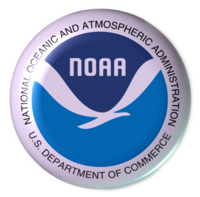National Oceanic and Atmospheric Administration
The National Oceanic and Atmospheric Administration is an agency of the United States government, under the authority of the Department of Commerce.[1]
NOAA works toward its mission through these seven major organizations in addition to several special program units:[2]
- NOAA National Weather Service
- National Environmental Satellite, Data, and Information Service
- National Marine Fisheries Service
- NOAA Ocean Service
- NOAA Research
- Office of Marine and Aviation Operations
- Office of Oceanic and Atmospheric Research
- Program Planning and Integration
Office of Oceanic and Atmospheric Research (OAR)
The Office of Oceanic and Atmospheric Research (OAR)is part of NOAA's research network consisting of 7 internal research laboratories, extramural research at Sea Grant universities, six undersea research centers, research grants funded by the Climate Program Office, and 13 cooperative institutes with various universities.[3]
The research conducted in the OAR laboratories and by the extramural programs focuses on environmental subjects such as hurricanes and tornados, solar flares, the ozone layer, air pollution transport and dispersion, El Niño/La Niña events, ocean currents, fisheries productivity and coastal ecosystems.[3]
Air Resources Laboratory
The Air Resources Laboratory (ARL) is one of the laboratories in the Office of Oceanic and Atmospheric Research.[4] It develops climate and air quality models including the transport, dispersion and removal of air pollutants from the ambient atmosphere. The specific goal of the ARL is to improve the prediction of trends, dispersion of air pollutant plumes, air quality, atmospheric deposition, and related variables.
References
- ↑ National Oceanic and Atmospheric Administration. Department of Commerce. Retrieved on 2007-11-17.
- ↑ NOAA Organizations. Department of Commerce. Retrieved on 2008-01-30.
- ↑ 3.0 3.1 About NOAA research. Department of Commerce. Retrieved on 2008-01-30.
- ↑ Air Resources Laboratory. Department of Commerce. Retrieved on 2008-01-30.
- CZ Live
- Earth Sciences Workgroup
- Chemistry Workgroup
- Biology Workgroup
- Chemical Engineering Subgroup
- Environmental Engineering Subgroup
- Articles written in American English
- All Content
- Earth Sciences Content
- Chemistry Content
- Biology Content
- Chemical Engineering tag
- Environmental Engineering tag
- Engineering Workgroup
